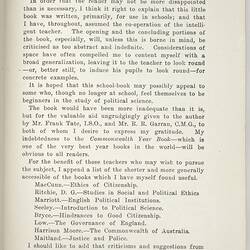Summary
Hardcover book by Walter Murdoch entitled 'The Australian Citizen. An Elementary Account of Civic Rights and Duties', published in 1912. The author states that the publication is primarily for use in schools. The contents outline the various structures and workings of the Australian Government as well as a chapter on the role and duties of citizenship. The author's introduction outlines what he considers to be the fundamentals of any 'good' society as well as the basic elements that link a society together. Predicated on Australia being a member of the British Empire, the key 'links' as articulated are: 'race' (primarily white and British); 'language' (English); 'religion' (Christian); 'tradition' (as relates to British history]; 'custom' and 'ideas'. His chapter on Citizenship outlines the objectives of a good 'citizenry' and notions of liberty, equality and duty to country. There is no recognition of the particular position of First Peoples' rights, identity and sovereignty.
Physical Description
Published book, blue hard cover with full title on front and abbreviated title on spine. Entitled: 'The Australian Citizen. An Elementary Account of Civic Rights and Duties' by Walter Murdoch, M.A. Inside frontispiece has an image of Parliament House, Melbourne and there are other images featured throughout the text. Published by Whitcombe and Tombs Ltd, Melbourne with the author Preface dated March 1912. 244 pages
Significance
This book adds to a developing collection of material relating to Australian citizenship and political notions of social cohesion and cultural identity. The publication offers an interesting insight into social and political attitudes and values in the early years of a federated Australia and reveals both the major shifts as well as continuities which would evolve over time in recognition of both multiculturalism and the ongoing importance placed on citizenship in Australia. It is also instructive in terms of the complete omission of First Peoples in this discussion about citizenship.
Issues of nationhood, national identity and citizenship have long been inextricably connected to discussions about migration and First Peoples. Since the nineteenth century and the evolution of notions of who should define and compose the Australian population - from the Australian Natives Association to the implementers of the White Australia Policy to First Peoples activists to multiculturalism - Australians have grappled with the question of identity. Colonial processes of naturalisation were in effect as far back as the 1850s and after World War II there was a great deal of activity surrounding the naturalisation of the waves of new migrants as well as annual citizenship conventions discussing related issues. The debate continues today in the form of citizenship tests and pledges.
More Information
-
Collecting Areas
-
Acquisition Information
Donation from Mr Michael Reason, Apr 2011
-
Author
-
Inscriptions
Front Cover: 'The Australian Citizen. An Elementary Account of Civic Rights and Duties' by Walter Murdoch, M.A. Inside page signed: 'Dulcie Evans/'Wolfston'/76 Foley St/Kew/1913'
-
Classification
-
Category
-
Discipline
-
Type of item
-
Overall Dimensions
130 mm (Width), 190 mm (Depth), 10 mm (Height)
-
Keywords
Citizenship, Government Policies, Politics, Race Relations, Indigenous Issues



